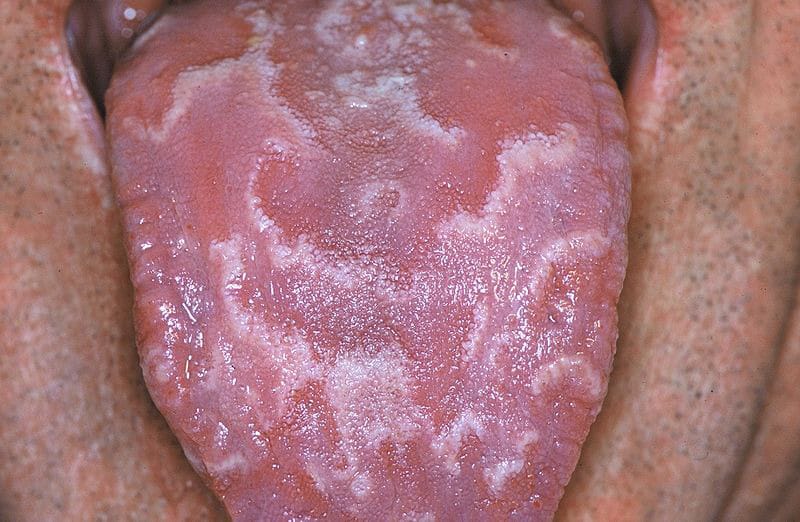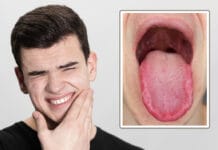My favorite subject in dental hygiene school was oral pathology, which remains true 18 years later in my dental professional career. I perform a complete oral evaluation on every patient during their routine appointment, and it seems I find one finding more than any other ‒ benign migratory glossitis, which many of us know as geographic tongue. In fact, I developed this condition myself in 2020.
Rayer first described benign migratory glossitis or geographic tongue (GT) in 1831 as a benign, chronic, and reoccurring inflammatory condition of the oral cavity of unknown etiology.1 Geographic tongue can occur as early as childhood and affects 1% to 2.5% of the population.2
Geographic Tongue Symptoms
The human tongue is covered in whitish to pinkish hairlike projections known as the papillae or taste buds. In those with geographic tongue, there is an absence of these papillae creating island-like lesions with raised borders. These smooth lesions of atrophic papillae can give the tongue a map-like or geographic appearance ‒ hence the name geographic tongue (see Image 1).3

These lesions can change in appearance, size, and location. Personally, my lesion changes in size but always occurs in the same area of the tongue. Lesions typically appear on the lingual and lateral border of the tongue; however, lesions have been noted on the lips, labial and buccal mucosa, as well as on the floor of the mouth.1 These particular lesions are termed geographic stomatitis and erythema migrans.2
Often, this condition is asymptomatic but can create a burning sensation on the tongue with an acidic or spicy diet. In some cases, the lymph nodes under the lower jaw (submandibular lymph nodes) may become enlarged.3
Geographic Tongue Etiology
The etiology of geographic tongue remains mostly unknown. However, some theories have been hypothesized. Psychosomatic and hereditary factors and mental illness are all suggested to have an increase in prevalence for this oral condition. Other suggestions are hormonal imbalances, allergies, and diabetes. Conclusive evidence is lacking for all of these theories.2
Patients infected with COVID-19 have reported tongue lesions as a symptom they experienced, prompting the name of COVID tongue. COVID tongue is essentially geographic tongue, according to Dr. Tim Spector, professor of genetic epidemiology at King’s College London.4 Since this symptom is not common, it does not make the official list of symptoms for COVID-19. Dr. Spector states that “one in five people still present with less common symptoms” and is seeing an increased number of COVID tongue.4 In one study, 6.6% of those affected with COVID-19 exhibited patchy depapillation.5
Psoriasis may increase the chance of developing this oral condition. Studies report that 10% of those with psoriasis also have geographic tongue.6 Evidence indicates that the complexity of psoriasis can affect the prevalence of geographic tongue, with 58% of those with GT also having severe psoriasis.6
Geographic Tongue Diagnosis and Treatment
Geographic tongue is diagnosed based on clinical findings and symptoms. Fortunately, this is a noncontagious disease but has very limited methods of treatment, if any. The avoidance of irritants is imperative for many such as spicy or acidic foods as well as alcohol. Symptomatic treatment includes oral rinses containing anesthetics, topical corticosteroids, vitamin A, antihistamines, and zinc supplements to help soothe tongue irritation.1
It is important for dental professionals always to perform an oral pathology exam during routine appointments. If evidence of geographic tongue is present, it is just as important to inform the patient of your findings. Because the discovery of GT is not shocking to dental professionals, it can often go unmentioned. Bringing the patient’s attention to this oral pathology condition will help eliminate fear or concern should the patient discover this on their own.
It will also serve to educate the patient on the ailment so they can be aware of how to treat it if it should become an issue. Dental professionals can make treatment suggestions if the GT is symptomatic. Discovery of this ailment may also help in the diagnosis of other aforementioned medical issues.
Geographic tongue is not a life-threatening condition, but it can be a major nuisance, especially if you like the heat in your diet. The lack of etiological evidence is frustrating, but with our education, we can help patients understand their condition better and help ease worry. A simple explanation followed by detailed information on reducing the incidence and increasing comfort can make all the difference in a patient suffering from geographic tongue. By educating patients on oral pathology findings, we are collectively corroborating that we are valuable resources to the medical world and are far more than just “teeth carpenters.”
Before you leave, check out the Today’s RDH self-study CE courses. All courses are peer-reviewed and non-sponsored to focus solely on high-quality education. Click here now.
Listen to the Today’s RDH Dental Hygiene Podcast Below:
Geographic Tongue References
- Shareef, S., Ettefagh, L. (2023, July 31). Geographic Tongue. StatPearls. https://www.ncbi.nlm.nih.gov/books/NBK554466/
- Radfar, L. Geographic Tongue. (2015, May 13). The American Academy of Oral Medicine. https://www.aaom.com/geographic-tongue
- Geographic Tongue. (2020, March 27). National Organization for Rare Disorders. https://rarediseases.org/rare-diseases/geographic-tongue/
- Booth, J. (2021, February 3). “COVID Tongue” – Dentists Urged to Remain Alert to Symptoms in the Oral Cavity. Dental Tribune. https://coronavirus.dental-tribune.com/news/covid-tongue-dentists-urged-to-remain-alert-to-symptoms-in-the-oral-cavity/
- Nuno-Gonzalez, A., Martin-Carrillo, P., Magaletsky, K., et al. Prevalence of Mucocutaneous Manifestations in 666 Patients with COVID-19 in a Field Hospital in Spain: Oral and Palmoplantar Findings. Br J Dermatol. 2021; 184(1): 184-185. https://doi.org/10.1111/bjd.19564
- Picciani, B.L.S., Domingos, T.A., Teixeira-Souza, T., et al. Geographic Tongue and Psoriasis: Clinical, Histopathological, Immunohistochemical and Genetic Correlation – A Literature Review. Anais Brasileiros de Dermatologia. 2016; 91(4): 410-421. https://pubmed.ncbi.nlm.nih.gov/27579734/












